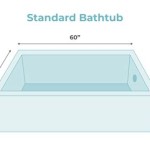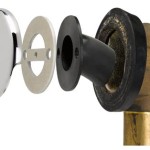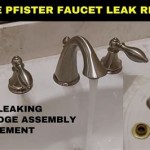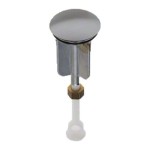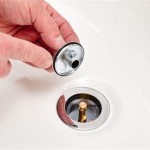```html
Understanding Plastic Bathtub Liner Protectors: A Comprehensive Guide
Plastic bathtub liner protectors represent a common solution for individuals seeking to either extend the lifespan of their existing bathtub or provide a temporary aesthetic upgrade. These liners, typically constructed from durable plastic materials like PVC or acrylic, are designed to fit snugly within the existing bathtub, effectively creating a barrier between the original tub surface and the water, soap, and other bathroom chemicals. The application of a plastic liner can address a range of issues, from cosmetic imperfections to structural concerns in older bathtubs, without the necessity of a complete bathtub replacement.
The market for bathtub liner protectors encompasses a variety of styles, sizes, and price points. While some liners are designed as universal fit solutions requiring trimming and customization, others are specifically manufactured to match the dimensions of particular bathtub models. Understanding the nuances of these different options is crucial for selecting the most appropriate liner for a given situation. Moreover, the installation process, although often presented as a DIY project, can present unforeseen challenges that necessitate professional assistance. This article aims to delve into the various aspects of plastic bathtub liner protectors, providing a comprehensive overview of their advantages, disadvantages, installation considerations, and long-term maintenance.
Key Benefits of Using a Plastic Bathtub Liner Protector
One of the primary advantages of utilizing a plastic bathtub liner protector lies in its potential to rejuvenate the appearance of a worn-out or damaged bathtub. Scratches, stains, and discoloration are common issues that can detract from the overall aesthetic appeal of a bathroom. A well-chosen and properly installed liner effectively conceals these imperfections, creating the illusion of a brand-new bathtub. This is particularly beneficial for individuals who are not in a position to undertake a full bathroom renovation but still desire to improve the look and feel of their bathing area.
Beyond the cosmetic benefits, plastic liners can also offer a degree of protection against further damage. Older bathtubs, especially those constructed from cast iron or porcelain, are susceptible to chipping and cracking. These vulnerabilities can lead to water leaks and structural deterioration over time. By providing a protective layer, the liner minimizes the direct exposure of the original tub surface to water and impact, thereby reducing the risk of further damage. This protective function can significantly extend the useful life of the existing bathtub, postponing the need for a costly replacement.
Furthermore, certain plastic bathtub liners are designed with antimicrobial properties. These liners incorporate materials that inhibit the growth of mold, mildew, and bacteria, contributing to a cleaner and healthier bathing environment. This is particularly advantageous in humid bathroom settings where moisture and warmth can promote microbial growth. The antimicrobial properties of the liner can reduce the frequency of cleaning and minimize the risk of developing unpleasant odors or unsightly stains.
Potential Drawbacks and Limitations
Despite their benefits, plastic bathtub liner protectors also have certain drawbacks that should be considered before making a purchase. One common concern is the potential for water to become trapped between the liner and the original bathtub surface. If the liner is not properly sealed or if cracks develop over time, water can seep into the space between the two surfaces. This trapped water can create a breeding ground for mold and mildew, leading to unpleasant odors, structural damage, and potential health problems. Regular inspection of the liner and proper sealing are essential to mitigate this risk.
Another potential limitation is the lifespan of the liner itself. While durable, plastic liners are not impervious to wear and tear. Over time, they can become scratched, stained, or cracked, particularly with heavy usage or exposure to harsh cleaning chemicals. The lifespan of a liner can vary depending on the quality of the materials used, the frequency of use, and the care taken during cleaning. It is important to research the expected lifespan of a particular liner before purchase and to follow the manufacturer's recommendations for cleaning and maintenance.
Furthermore, the aesthetic appeal of a plastic liner may not be comparable to that of a brand-new bathtub. While liners can effectively conceal imperfections, they may not replicate the look and feel of high-end bathtub materials like cast iron or acrylic. The appearance of the liner can also be affected by the skill of the installer. An improperly installed liner may have visible seams, gaps, or bulges, detracting from the overall aesthetic result. It is important to carefully consider the aesthetic limitations of plastic liners before making a decision.
Installation Considerations and Best Practices
The installation of a plastic bathtub liner protector is a critical step that can significantly impact its performance and longevity. While some liners are designed for DIY installation, others may require professional assistance. Regardless of the chosen approach, careful preparation and attention to detail are essential for a successful installation.
Before beginning the installation process, it is crucial to thoroughly clean and prepare the existing bathtub surface. Any loose paint, rust, or debris should be removed to ensure proper adhesion of the liner. Cracks and holes in the original tub should be repaired to prevent water from seeping behind the liner. The surface should be completely dry before applying any adhesive or sealant.
The proper sealing of the liner is perhaps the most important aspect of the installation process. High-quality waterproof sealant should be applied around the edges of the liner, as well as around any fixtures such as faucets and drains. The sealant should be applied evenly and smoothly to create a watertight barrier. Regular inspection of the sealant is necessary to identify and repair any cracks or gaps that may develop over time.
For DIY installations, it is essential to carefully follow the manufacturer's instructions. Incorrect installation can lead to leaks, improper fitting, and premature failure of the liner. If unsure about any aspect of the installation process, it is advisable to seek professional assistance from a qualified plumber or bathroom renovation specialist. Professional installation can ensure a proper fit, watertight seal, and long-lasting performance of the liner.
Choosing the right adhesive is also a crucial step in the installation process. The adhesive should be specifically designed for use with plastic bathtub liners and should be compatible with the material of the existing bathtub. The adhesive should be applied evenly and according to the manufacturer's instructions to ensure proper bonding between the liner and the original tub surface. Avoid using excessive amounts of adhesive, as this can create bulges or unevenness in the liner.
Ventilation is also a key consideration during and after the installation process. Ensure adequate ventilation in the bathroom to allow the adhesive and sealant to dry properly. Avoid using the bathtub until the adhesive and sealant are fully cured, as this can disrupt the bonding process and lead to leaks. Follow the manufacturer's recommendations for curing time and ventilation requirements.
Long-Term Maintenance and Care
Proper maintenance and care are essential for extending the lifespan and preserving the appearance of a plastic bathtub liner protector. Regular cleaning and inspection can help prevent the buildup of mold, mildew, and stains, as well as detect any signs of damage or wear.
Cleaning the liner regularly with a mild soap and water solution is recommended. Avoid using harsh abrasive cleaners or scouring pads, as these can scratch or damage the plastic surface. A soft cloth or sponge is ideal for cleaning the liner. Rinse thoroughly with clean water after cleaning to remove any soap residue.
Inspect the liner regularly for any signs of cracks, gaps, or discoloration. Pay particular attention to the areas around the edges and fixtures, as these are more prone to damage. If any cracks or gaps are detected, they should be repaired promptly with waterproof sealant. Discoloration or staining can often be removed with a specialized plastic cleaner. If the liner becomes severely damaged or stained, it may need to be replaced.
To prevent the buildup of mold and mildew, ensure adequate ventilation in the bathroom. After each use, wipe down the liner with a clean, dry towel to remove excess water. Consider using a dehumidifier in the bathroom to reduce humidity levels. Regularly clean the bathroom exhaust fan to ensure proper ventilation.
Avoid dropping heavy objects onto the liner, as this can cause cracks or dents. Be mindful of sharp objects that could scratch the surface of the liner. Avoid using harsh chemicals or solvents in the bathtub, as these can damage the plastic material. Follow the manufacturer's recommendations for cleaning and maintenance to ensure the longevity and performance of the liner.
```
Oatey 14 In 16 Adjustable Plastic Bathtub Liner Protector 34126

Oatey 5 Ft Plastic Bathtub Liner Protector 34069 The Home Depot

Oatey 5 Ft Plastic Bathtub Liner Protector 34069 The Home Depot

Oatey 5 Ft Plastic Bathtub Liner Protector 34069 The Home Depot

Oatey 14 In 16 Adjustable Plastic Bathtub Liner Protector 34126

Oatey 5 Ft Plastic Bathtub Liner Protector 34069 The Home Depot

Bathtub Protection Liner Axiom Temporary Surface

Oatey 14 In 16 Adjustable Plastic Bathtub Liner Protector 34126

Oatey Black Bathtub Protector 34069 At Com

Oatey 14 In 16 Adjustable Plastic Bathtub Liner Protector 34126
Related Posts

